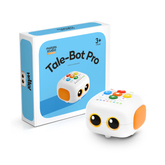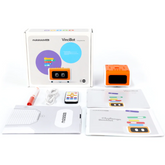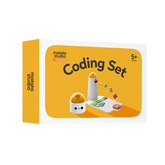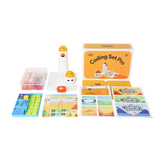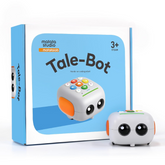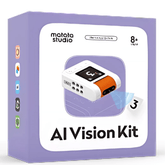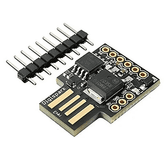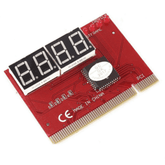Top 12 Screen-Free Coding Project Ideas for Kids
Summary
Kids are natural explorers, always eager to build, play, and discover. But with screens everywhere, many parents and teachers are searching for ways to spark creativity and learning—without more digital exposure. That’s where screen-free coding project ideas come in! These hands-on activities, inspired by innovative Matatalab kits from Robocraze, make coding fun, interactive, and accessible for all ages.
Whether you want to nurture problem-solving skills in kids, introduce robotics for kids, or simply provide engaging STEM education for kids, this guide is packed with ideas that ignite imagination and build real-world skills.

What is Coding for Kids?
Coding for kids is about teaching children the basics of programming in a playful, age-appropriate way. Instead of focusing on complex syntax, these activities use physical blocks, robots, and tangible modules to help kids learn to code for kids. By giving step-by-step instructions to robots or completing hands-on challenges, children develop computational thinking and a strong foundation for future learning.
Why Coding is Important for Kids

Learning to code is about more than just computers. Here’s why coding is important for kids:
- Develops problem-solving skills in kids by encouraging them to break down big challenges into smaller steps.
- Boosts creativity and confidence as they see their ideas come to life.
- Strengthens logical thinking and attention to detail.
- Prepares them for a tech-driven future with essential STEM education for kids.
- Encourages teamwork and communication through collaborative projects.
With coding project ideas that are screen-free, kids can experience the magic of creation and discovery—no screens required!
What Are Coding Projects?
Coding projects are activities where kids use programming concepts to build, create, or solve problems. Screen-free coding activities use physical kits, cards, and robots to make these concepts tangible. These projects are perfect for introducing coding activities for kids, making learning interactive and fun while building skills that last a lifetime.
12 Unique Screen-Free Coding Project Ideas
Below are twelve inspiring coding project ideas—all based on Matatalab kits available at Robocraze. Each project is designed to be hands-on, engaging, and educational, helping kids learn to code for kids while having fun.
1. Storytelling Adventure
Transform your home into a world of adventure! Kids use the MatataStudio Pro Coding Robot Set to create a story map and program the robot to travel through different scenes, like jungles, cities, or outer space. This project encourages creativity, sequencing, and computational thinking.
The MatataStudio Pro Coding Robot Set is a versatile kit that introduces young learners to the fundamentals of coding through playful robotics. Kids will learn key concepts like sequencing commands, basic logic, and how to plan step-by-step actions to achieve a goal.
It's valuable because it combines storytelling with technology, helping children develop narrative skills alongside programming basics, which fosters both creative and analytical thinking.
Suitable for ages 4-9, this set features a cute robot, colorful coding blocks, and map tiles that make learning intuitive and fun. Other features include wireless connectivity for easy programming and expandable accessories for more advanced stories.
2. TaleBot’s Treasure Hunt
Kids design a treasure map and use coding cards to guide TaleBot to hidden treasures. This activity builds logic and sequencing skills, making it a favorite among coding activities for kids.
The MatataStudio TaleBot Coding Robot Kit is an entry-level robotics tool perfect for sparking curiosity in young minds.
Through this STEM project, children learn about algorithms, directional commands, and debugging by adjusting their card sequences when the robot doesn't follow the path correctly.
It's valuable as it turns coding into a game, teaching persistence and logical reasoning in a low-pressure way, which is essential for building confidence in problem-solving skills in kids.
Ideal for ages 3-6, the kit includes a small, friendly robot that responds to voice commands and coding cards, with features like sound effects and simple movements that keep kids engaged without any screens.
3. AI-Powered Sorting Game
Kids use the Nous AI Set to build a robot that sorts objects by color or shape. This hands-on project introduces AI concepts and strengthens problem-solving skills in kids.
The MatataStudio Nous AI Set brings artificial intelligence into playtime, allowing kids to experiment with smart robotics.
They’ll learn about pattern recognition, decision-making algorithms, and basic AI principles by programming the robot to categorize items. This is valuable because it demystifies AI, showing how technology can solve everyday problems, which prepares kids for a future where tech is everywhere and enhances their computational thinking.
Suitable for ages 6-10, the set includes sensors for color and shape detection, modular parts for building, and app-free programming options that emphasize hands-on learning.
4. Sports Challenge
Kids set up a mini football or basketball game using the 3-in-1 Smart Sports Kit for VinciBot. Program the robot to kick a ball, score a goal, or race around obstacles—perfect for teamwork and friendly competition.
The 3-in-1 Smart Sports Kit for VinciBot combines physical activity with coding, turning sports into a learning opportunity. Children learn about motion control, timing, and conditional statements as they code the robot to interact with balls and obstacles.
It's valuable for promoting active play while teaching coding, which helps develop coordination, strategy, and social skills through group challenges.
Best for ages 8+, this kit features interchangeable sports accessories, durable robot components, and integration with VinciBot for versatile programming that grows with the child's skills.
5. Dancing Robot Show
Kids program VinciBot to perform a dance routine, using lights, sounds, and movements. This project introduces sequencing, loops, and creative expression, making it a standout in robotics for kids.
The Matatalab VinciBot STEM Educational Coding Robot is a robust kit that encourages artistic coding. Kids will learn about loops, synchronization, and event-based programming by choreographing dances with audio and visual effects.
Its value lies in blending arts with STEM, helping children express themselves while grasping coding rhythms, which boosts creativity and technical understanding.
Suitable for ages 8+, it includes LED lights, speakers, and block-based coding that's expandable for more complex routines.
6. Engineering Marvels
Build bridges, cranes, or even a walking spider! With over 400 building blocks, this kit lets kids create mechanical structures and program them to move. It’s a fantastic way to explore engineering and STEM education for kids.
The Matatalab 20 in 1 Creator STEM Kit is packed with building possibilities, teaching kids about mechanics, gears, and basic programming for motion.
They learn structural design, cause-and-effect relationships, and how to code movements, which is valuable for fostering innovation and hands-on engineering skills that apply to real-world inventions.
Ideal for ages 6-12, features include 400+ compatible blocks, motors, and a guidebook for 20 projects that encourage experimentation.
7. Smart Weather Station
Kids build a weather station using the temperature and humidity sensor from the Matatalab 5 in 1 kit. Program VinciBot to display weather data or trigger lights based on temperature changes. This project teaches data collection and real-world problem-solving skills in kids.
The Matatalab 5 in 1 Programmable Electronic Module Kit introduces electronics through practical builds.
Children learn sensor integration, data interpretation, and conditional coding, making it valuable for understanding environmental science and tech applications. Suitable for ages 8+, it offers five modules like sensors and LEDs, with easy VinciBot compatibility for custom projects.
8. Joystick-Controlled Maze Runner
Use the joystick module from the Matatalab 5 in 1 kit to guide VinciBot through a custom-built maze. Kids learn about input devices, control flow, and debugging as they refine their code to complete the maze efficiently.
This robotics kit expands on electronics with interactive controls, teaching input-output relationships and real-time programming. It's valuable for developing fine motor skills and persistence through trial and error. For ages 8+, features include modular joysticks and bricks for endless mazes.
9. Color Line Following
With the AI Vision Kit, kids program VinciBot to follow a path based on color recognition. This project introduces computer vision and shows how AI can help robots navigate the world.
The AI Vision Kit for VinciBot adds visual AI capabilities, where kids learn image processing and pathfinding algorithms. Valuable for exploring robotics navigation, it's suited for ages 8+ with camera modules and training tools.
10. Handwriting Recognition Challenge
Kids write numbers 0–9 on cards and use the AI Vision Kit to train VinciBot to recognize and respond to each number. This activity introduces machine learning and personalized AI training in a hands-on way.
Building on AI, this teaches model training and recognition, valuable for understanding data-driven tech. Ages 8+, with customizable training features.
11. Smart Light Show
Kids program VinciBot to control an LED strip and create a custom light show. They can use loops, timing, and color changes to design patterns, making this a fun introduction to electronics and STEM project ideas.
Using the 5 in 1 kit, kids learn timing and output control, valuable for creative electronics. Ages 8+, with expandable LEDs.
12. Robot Orchestra
Kids use the Matatalab 5 in 1 Programmable Electronic Module Kit to build different musical instruments (like drums, maracas, or xylophones) using building bricks and sensors. Program VinciBot to play a sequence of notes or rhythms, or even coordinate multiple robots for a full band performance. This project introduces the basics of algorithms, timing, and creative expression through music.
This kit enables sound-based coding, teaching synchronization and sequencing. Valuable for musical STEM integration, ages 8+, with sensors for custom instruments.
Conclusion
Screen-free coding project ideas open up endless possibilities for creativity, learning, and fun—without the need for extra screen time. Whether your child is building robots, solving puzzles, or inventing new games, these projects nurture essential skills that will last a lifetime. With Matatalab kits from Robocraze and a little imagination, every child can start their journey into coding, robotics, and beyond. The future is bright, hands-on, and full of possibilities!



